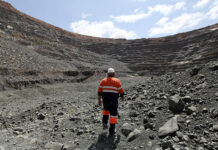
THE diamond market was showing signs of recovery, but risks abounded as a resurgence in Covid-19 disease rippled through Europe and elsewhere, said Petra Diamonds.
Commenting in a trading update, in which it reported improved production in the first quarter, and a marginally better balance sheet, Petra said the risks to a level of recovery in diamonds were for all to see.
“All participants in the industry recognise that risks to a sustained recovery remain, particularly in light of the current resurgence of Covid-19 in key diamond markets,” said Petra in its update. The level of consumer activity, especially in the US market, would be a key development.
Petra’s trading update comments come as it seeks to put the most tumultuous period in its history behind it.
On October 20, the company said it would convert about half of loan note debt to shares, presenting 91% of its enlarged share capital to note holders. This extraordinary step was after failing in March to pay interest on $650m in loan notes, triggering an ad hoc group of shareholders to call on the principle outstanding amount.
Petra raised the debt in order to chase down an ambitious five million carats per year expansion strategy. However, the company’s ability to generate sufficient cash flow to manage its debt foundered owing to production problems and a decline in the diamond market, exacerbated by the onset of Covid-19 lockdowns.
Richard Duffy, CEO of Petra, said today in a statement that the agreement with bondholders, as well as the group’s South African lender group “… will provide us with a considerably more manageable level of debt going forward”.
The firm’s South African mines were returned to full production, partly thanks to a continuous operations agreement with unions that would be carried through until year-end at least, in order to aid recovery. As a result of the return to full production, year-on-year first quarter production came in at 974,346 carats. This was some 10% lower owing to the mothballing of the Williamson mine in Tanzania earlier this calendar year.
Williamson would be reinstated once the diamond market had sufficiently recovered, said Petra. There were signs of market recovery: diamond prices were 21% higher on a like-for-like basis in the first quarter and contributed towards a 33% improvement in quarterly revenue of $82m, assisted by the carry-over of fourth quarter inventory.
Petra is also hoping for a revenue boost from the sale of five high quality type 11b blue diamonds “of significant clarity and size”, recovered at the firm’s Cullinan mine. The diamonds, known as the ‘Letlapa Tala Collection’, would be sold in a special tender to be finalised end-November.
The diamond market, however, remains delicate. Petra embarked on a flexible tender process during the Covid-19 lockdowns which would continue. “Risks to tender timing remain as a result of possible restrictions that may be re-imposed following a second wave of Covid-19 infections being experienced in a number of countries, including Belgium,” it said. Prices in the second quarter were a modest 2% higher on a like-for-like basis.
Earlier this month, De Beers reported diamond sales totalling $467m for its eighth sight – a 40% increase over the confirmed seventh sight sales – in a sign that the diamond market continued to improve ahead of its key Thanksgiving and Christmas festivals. Its CEO, Bruce Cleaver warned, however, it was “early days”, and that there was “… a long way to go before we can be sure of a sustained recovery in trading conditions”.
Debt was reined in only marginally, falling to $687.8m as of end September from $693.2m previously.
In an effort to boost cash flow, the company embarked on a business improvement programme. The programme, Project 2022, would deliver $101m in throughout initiatives by 2022 whilst cost optimisation savings of some $22m had been booked for this year.
Petra said Project 2022 would also deliver a “cleaner structure” with revised job descriptions that would improve accountability.










